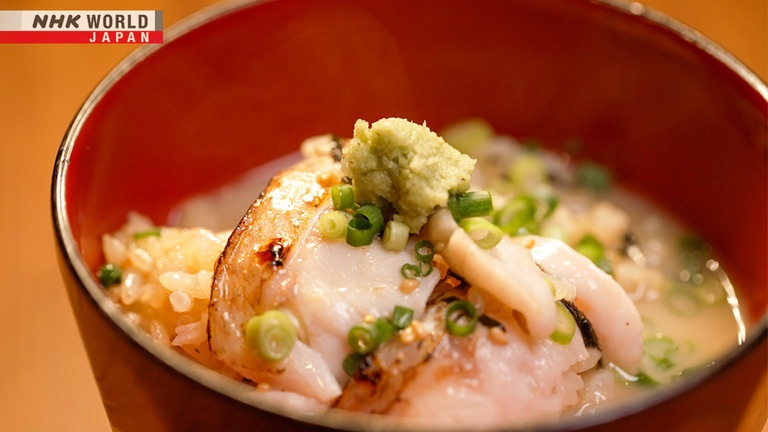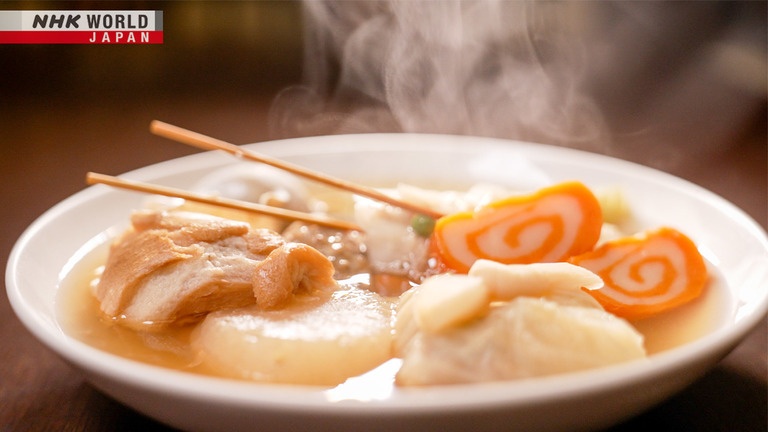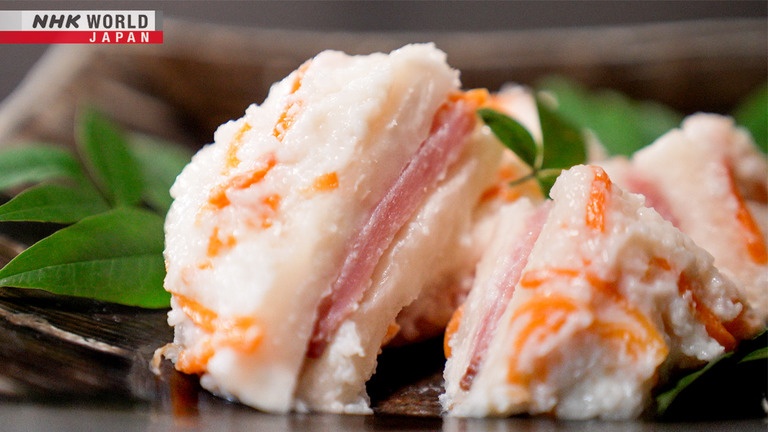Cook Around Japan - Kanazawa: Food from a Samurai City
Let's embark on an exploration of food from the era of the samurai. In Kanazawa, you can enjoy dishes that lords and samurai used to love—and newly evolved local cuisine too!
(1) Nodoguro Rice

Ingredients
Nodoguro (blackthroat) fillet
Rice
Miso
Sea salt
Condiments:
Scallions (sliced)
Wasabi
Sesame seeds
Nodoguro broth
Directions
1. Cook the rice with miso-seasoned water.
2. Slice the sashimi quality nodoguro fillet and place onto the rice.
3. Sprinkle with sea salt and sear with a blow torch just before serving.
4. At first, taste as is; then with wasabi, scallions and sesame seeds, and finally pour the nodoguro broth over the rice and slurp!
(2) Kanazawa Oden

Ingredients
Niboshi (dried small sardines)
Kombu kelp
Usukuchi soy sauce
Vegetables and seafood (for example: fishcake, potato, shellfish and "Kurumafu")
Directions
1. Make the dashi broth using niboshi and kombu with soy sauce.
2. Gently simmer the ingredients with the dashi broth to fully absorb its umami flavor.
(3) Kabura-zushi

Ingredients
Japanese turnips
Yellowtail (buri)
Fermentation mash (from rice koji and steamed rice)
Carrot
Directions
1. Sandwich the matured and sliced buri in a turnip.
2. Prep a small barrel (or something similar) and place the koji mold mixture and turnip sandwich.
3. Fully cover the turnip with the koji and shredded carrot, cover the barrel weighing down the top.
4. After a few weeks, it ripens with umami flavor. Cut into small pieces and enjoy!
Transcript
Dining with the Chef.
Hi, welcome to Cook around Japan.
I'm your host Yu Hayami.
Today, I'm visiting the city of Kanazawa in Ishikawa Prefecture.
Kanazawa is one of the most popular tourist destinations in Hokuriku,
the northwestern part of Japan's main island, Honshu.
It's a city where you can still experience the atmosphere and lifestyle of old Japan.
This sets it apart from Tokyo, making it a popular destination for overseas travelers.
And one of its many attractions is the food!
Kanazawa is also famous of its rich culture and sophisticated food culture.
So join me now as I savor Kanazawa's many delights.
Let's explore Japan's cuisine in greater depth.
Japan is a chain of islands approximately 3,000 km long from north to south.
There's a large variation in climate,
and the terrain in each region has given rise to a diverse culture of food.
Today, we head to Ishikawa Prefecture in Hokuriku, northwestern Japan.
The capital, Kanazawa, was one of the most powerful castle towns in feudal Japan,
dating back to around 1600.
It's tranquil and refined beauty makes it a popular destination for seasoned travelers.
During the Edo period, the lord of the domain, fostered the development of culture,
rise to a whole array of exquisite arts and crafts.
With access to the bounties of the Sea of Japan and fertile inland fields,
Kanazawa boasts some of Japan's best ingredients.
The traditional cuisine, enjoyed by feudal lords and samurai, has evolved along with the times.
Welcome to Cook Around Japan: Kanazawa.
Today, we'll discover the food from a samurai city.
Kanazawa Castle stands in the center of the city of Kanazawa.
The Omimachi Market, has been beloved by the people of Kanazawa as a food source.
I'm at Omicho market, which is located in the Kanazawa's city center.
This area is the core of Kanazawa's food culture.
With a history of 300 years, this market has developed along with the city
and is known fondly as the kitchen of Kanazawa.
Fresh seafood and produce from all over the Ishikawa region can be found here.
The near-by fishing grounds, where warm and cold currents meet,
have long delighted the feudal lords and citizens
with the wide variety of fish and shellfish that can be caught in the area.
Wow! Look at all this fresh seafood!
There's so many different varieties.
Is anything you recommend for today?
Flying squid are in season.
These were caught this morning.
See? They're still alive.
I mean, he is so cute.
I don't think I can eat you, but you are delicious.
What's the best way to eat this?
Definitely sashimi!
It's in season, so it's
rich, sweet and absolutely delicious!
With a little bit of ginger and soy sauce.
Oh, I can just Imaginate.
Semi-dried fish, or "himono," is another specialty of the Ishikawa region.
It has been beloved by the people of the region as a rich resource,
originating some 1,000 years ago.
"Ichiya-boshi" - or fish cured overnight, is especially famous here.
Fresh fish is soaked
in brine and semi-dried.
It's "ichiyaboshi": "dried overnight."
That's much less time than normal.
So by doing that, how does the taste of the fish change?
The excess water is released, so it's easier to grill.
It also concentrates the umami flavor.
If dried for long, fatty fish
will lose its tasty fat.
So, "ichiyaboshi" is best for grilling.
This dish allows you to enjoy a wide variety of seafood in one go.
No wonder it's popular.
An assortment of seasonal fish on a bed of sushi rice.
Each piece of sashimi is of premium quality and taste.
There's one fish that's especially popular,
cementing Kanazawa's fame as the go-to place for sashimi rice bowls.
Our bowls feature an array
of fresh local seafood.
But 80% of the tourists come for
"nodoguro," blackthroat seaperch.
It's the king of white fish.
"Nodoguro" is a luxury fish, known for its delicate sweetness and rich flavor.
It's in season all year round.
But because it's difficult to land and distribute, it's rarely served outside of Kanazawa,
except in high-end restaurants.
One restaurant has come up with a special dish that brings out the exquisite flavor of "nodoguro."
"Nodoguro" is a deep-sea fish.
It inhabits cold waters, so it's
fat and tasty all year round.
Prep and clean the fish and slice into sashimi.
Place on a bed of miso-seasoned rice and sprinkle with locally harvested sea salt.
Then sear it, just before serving.
Searing draws out the fat
between the skin and meat.
So the sweet flavor and aroma
of the fat bursts in your mouth.
If you grill the fish,
you'll lose the fat.
But searing gives you optimum flavor.
We buy "nodoguro" every day.
To draw out the fat, it has to be fresh.
Wow! That looks beautiful.
It looks perfectly charred.
The aroma is wonderful.
First, eat the fish on rice, without any condiments.
It smells so nice.
That's so delicious.
The fish is firm and yet very soft and it's so flavorful.
And because it's charred on the outside it tastes a bit roasty... very nice.
Then, try it with scallions and wasabi.
And finally, with "dashi."
Three ways to enjoy the "nodoguro" on rice.
Oh, wow!
For this broth, we simmer the
"nodoguro" bones for several hours.
Interesting. Why is it white?
After 3 hours, the calcium and
fat from the bones seep out.
It takes 6 hours to produce
a white broth.
Oh, interesting.
It's kind of like "nodoguro risotto."
Very nice.
It has so much flavor.
This is really nice.
"Nodoguro" is an exquisite fish that
is served at high-end restaurants.
It's for special occasions and
not something you have every day.
The way of preparing it was conceived to make the exclusive fish, more accessible to seafood lovers.
The sweet fat that oozes out when
seared is the hallmark of "nodoguro."
This dish offers you the full flavor
of "nodoguro" down to the last drop.
Kanazawa has long been famous for its fresh and delicious seafood.
It's well worth checking out.
Now for a local specialty that can be traced back to the days of the samurai.
Traditional "fu."
"Fu" is a glutenous material, like a sponge, and absorbs the liquid it's been cooked in.
It's an essential ingredient in Japanese cuisine.
"Fu" is a common ingredient in Kanazawa's traditional cuisine.
Kanazawa was the seat of the Kaga Domain, which is why the "fu" made here is called "Kaga-fu."
Located in the center of the city is a store that has been making it since around 1865.
It continues to make "fu" by hand, preserving the culture and tradition of "Kaga-fu."
Introduced from China, "fu" is made of
wheat gluten. It's vegetarian protein.
It's said to have been invented by
Buddhist monks who did not eat meat.
Kyoto, with its many temples,
popularized "fu" centuries ago.
The roots of "Kaga-fu" can be
traced back to the late 16th century
"Kaga-fu" evolved out of Kyoto's "fu"
culture. It's very different.
Wheat gluten, in the hands of skilled craftsmen, is turned into miniature works of art.
"Kaga-fu" is one of Kanazawa's local specialties.
Today, "Kaga-fu" has become part and parcel of everyday cooking in Kanazawa.
It has an interesting texture.
It's firm but fluffy.
It doesn't taste of much, but it absorbs
the flavor of the "dashi" it's cooked in.
Many of the shapes have been developed over time.
One of the most popular and beloved shapes in Kanazawa is "kuruma-fu," which look like the wheels of a cart.
Wheat gluten and flour are kneaded into
a dough and wrapped around a long rod.
This is then baked in an oven.
More dough is wrapped around it and
baked like a German tree cake.
This is repeated 3 times to form a
fluffy "fu," like a ring doughnut.
Kanazawa's favorite comfort food has become a big draw for tourists eager to try Kanazawa's specialty "fu."
"Oden" is a hot pot of various ingredients simmered in a flavorful "dashi."
Kanazawa "oden" is a local specialty that has achieved nationwide fame.
The key to the "oden" is the "dashi" broth.
We opened in 1953.
There are no set rules for the "dashi"
in Kanazawa "oden."
Each restaurant has its own blend
which is replenished every day.
Ours is a pale "dashi"
seasoned in the Kansai style.
This pale "dashi," is made from dried sardines and "kombu" and seasoned with "usukuchi" soy sauce.
It has a refined taste.
Rich in umami, it's used to simmer a medley of Kanazawa local specialties.
We use an abundance of local seafood.
The red and white pinwheels
are "kamaboko" fish cakes.
It adds color to the "oden."
People say our "oden" is sumptuous.
The ingredients soak up the broth, while releasing individual flavors, adding depth to the broth.
This synergy of flavors is what makes "oden" so special.
The wheel-shaped "kuruma-fu," steeped in broth, is bursting with flavor.
The dry "fu," is reconstituted in water and squeezed out before adding to the broth.
It takes 2 hours for the "fu"
to fully absorb the broth.
It's like eating broth.
The "fu" best conveys
the quality of the broth.
I don't know how it came about, but "fu"
is the trademark of Kanazawa "oden."
A local specialty that can only be eaten here in Kanazawa.
These days, there are tourists who come to Kanazawa just for the "oden."
Families enjoy coming here.
"Oden" is a perfect for groups who
want to have fun talking together.
That's the best way to enjoy it.
It goes well with hot sake.
Budget-friendly "oden," packed with what used to be considered high-end ingredients.
"Oden" and sake, a perfect match.
Finally, a look at an unusual type of sushi, that is a specialty of Kanazawa,
where it is has long been a custom to present it as a gift.
A store specializing in fermented food products, said to be founded in 1875.
How about a refreshing yogurt-like drink, that is perfect on a hot summer day?
Very good. It's slightly sweet but there's an aftertaste of what you would taste when you have "amazake."
And there are little bits of, I am guessing, rice?
This is "koji amazake."
It's a fermented drink made
from rice "koji" and rice.
No sugar has been added.
It's naturally sweet.
So can you explain to us what "koji" is?
"Koji" is a mold used to ferment grains.
"Koji" is made by introducing "koji" mold to steamed rice, barley, soybeans, or other grains.
It plays a fundamental role in Japan's fermented food products.
It is used to make miso, sake, and soy sauce.
Kanazawa is home to many
unique fermented foods.
Fermented foods have long
been enjoyed on a daily basis.
Our winters are cold and humid,
ideal for controlling fermentation.
Kanazawa is a treasure trove of seafood with a climate that is perfect for fermentation,
encouraging the development of a sophisticated fermentation technology.
The feudal lords of the domain encouraged the development of fermented foods
made from seafood and locally grown vegetables.
These were exported all over Japan, contributing to the region's prosperity.
One of the fermented foods unique to Kanazawa was highly coveted and was sent out as gifts.
Let's find out more about it.
Sushi typically refers to
seafood on sushi rice.
But "kabura-zushi" is a "nare-zushi," the
most primitive form of sushi in Japan.
It's an ancient style of sushi made by
fermenting rice, vegetables or fish.
A special "kabu" or turnip, is cultivated exclusively for "kabura-zushi" in and around Kanazawa.
Salt-cured turnips.
Make an incision.
Sandwich a slice of yellowtail(buri).
The yellowtail has been preserved in salt for two weeks in a temperature-controlled environment.
So first I take a piece of beautiful radish.
And put my finger here to open up it a bit.
And then we take a piece of buri fish and we made like so.
And we push it in so that it doesn't come out of the sides.
This is then fermented in a mash of steamed rice and rice "koji."
Rice "koji" is added to steamed rice.
An enzyme called amylase breaks down
the starch in the rice.
This causes a release of glucose.
Pickled vegetables produce lactic acid
which is then digested by the glucose.
This produces sourness and flavor.
That's how the fermentation works.
The practice of fermenting fish in rice, dates back to time immemorial.
It's the origin of modern-day sushi.
It can be made at home, but if you come to Kanazawa, you can take part in a workshop.
Nowadays, very few people know how to make.
That's why we organize workshops.
I'm the teacher.
The pickled turnips are stacked in a barrel and covered with more fermentation mash.
We then cover and weigh it down.
After that, we just wait.
You did very well.
After about a week, the "kabura-zushi" should be properly fermented.
So, what does it taste like?
I don't think I've ever had "kabura zushi."
I hope you'll like it.
It's such a gentle flavor.
Yes, people imagine it to be quite pungent.
But it has a mild and
sophisticated flavor.
And very delicate in flavor.
When I first walked into the store I had the pleasure of trying the "amazake,"
and I can see how they're all related.
And of course you can taste the "buri," the fish as well. It's very nice.
Yellowtail has always been a very
special fish in Kanazawa.
In the feudal days, distribution
was controlled by the government.
It was so valuable that it was
out of reach for most people.
Even today, "kabura-zushi" is presented as a gift on special occasions.
"Kabura-zushi" has always been
presented to people of importance.
The desire to send good food to someone
special is probably in our blood.
It's imbedded in the culture
and tradition of Kanazawa.
Do the people do young people eat this sushi as well, "kabura-zushi" as well?
Not that many, no.
Most children don't like the taste.
But interestingly enough,
it gradually grows on them.
People over the age of 30 tend to like it.
Many of my friends share this feeling.
I can see why the radish is very good and it's very mellow tasting.
However, there is a little bite to it.
The flavor of fermented products is affected by the climate and water of the region.
So, "kabura-zushi" is something very special found in Kanazawa.
I highly recommend it because you can't take it home with you.
It doesn't last that long, but it makes it all the more special.
If you have a chance to come here,
do give it a try.
If you can appreciate the flavor of "kabura-zushi,"
consider yourself a true connoisseur of Japanese cuisine.
I hope you enjoyed the many different types of cuisine introduced in this episode.
Kanazawa's age-old cuisine continues to evolve and thrive in accordance to the times.
The people of Kanazawa feel very strongly about their cultural heritage,
which is why Kanazawa's cuisine is so interesting.
Enjoying the food will provide an insight into the city itself.
Thank you for joining me and Cook around Japan until next time.
See you.